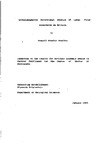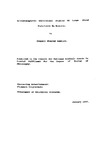Archaeomagnetic Directional Studies Of Large Fired Structures In Britain
| dc.contributor.author | Gentles, Dougall Stanley | |
| dc.contributor.other | School of Geography, Earth and Environmental Sciences | en_US |
| dc.date.accessioned | 2013-10-23T11:54:11Z | |
| dc.date.available | 2013-10-23T11:54:11Z | |
| dc.date.issued | 1989 | |
| dc.identifier | NOT AVAILABLE | en_US |
| dc.identifier.uri | http://hdl.handle.net/10026.1/2326 | |
| dc.description | Merged with duplicate record 10026.1/820 on 14.02.2017 by CS (TIS) | |
| dc.description.abstract |
Archaeomagnetic directional dating of several Scottish sites has been undertaken by extensive sampling of large, physically stable vitrified exposures. Isothermal remanences and the demagnetisation patterns isolated using alternating magnetic fields and thermal methods, show that vitrification occurred under limited oxidation at temperatures >600°C and that the vitrification was physically stable below 600°C at all but one of the sampled structures. Remanence directions were isolated by demagnetisation techniques and show that these sampled forts and duns collectively span a period from the late 3rd century B.C. to 5th century A.D. Calibration of mean magnetic directions shows general consistency with 14c dating but not with thermoluminescence dates. An archaeomagnetic curve of "best fit" incorporating all dating methods largely confirms the previous Iron Age secular variation curve. Field observations, systematic sampling and magnetic measurement of features of various archaeological ages, as well as an experimental kiln, has shown that there are both random and systematic directional deviations which do not precisely correlate with other magnetic properties. These deviations are thought to be due to more complex factors than that suggested by standard refraction corrections and appear to be attributable to not only magnetic distortions through already cooled magnetic materials but also complex localised magnetic interactions during cooling. Magnetic heterogeneity can contribute toward randomising such effects. Movement on cooling was insignificant in most cases whilst fabric anisotropy did not cause significant magnetic deflections. Systematic and preferential sampling of rapidly cooled areas gives the most consistent results, although mean magnetic directions from slowly cooled and magnetically heterogeneous structures can also give well defined magnetic directions. | en_US |
| dc.language.iso | en | en_US |
| dc.publisher | University of Plymouth | en_US |
| dc.title | Archaeomagnetic Directional Studies Of Large Fired Structures In Britain | en_US |
| dc.type | Thesis | en_US |
| dc.identifier.doi | http://dx.doi.org/10.24382/1309 | |
| dc.identifier.doi | http://dx.doi.org/10.24382/1309 |
Files in this item
This item appears in the following Collection(s)
-
01 Research Theses Main Collection
Research Theses Main



